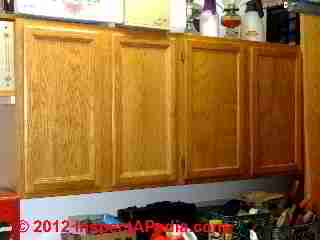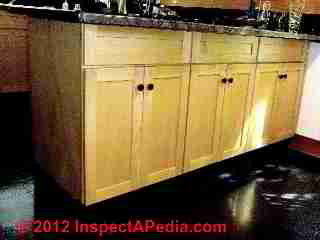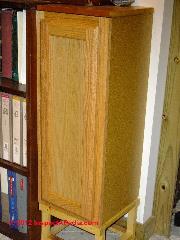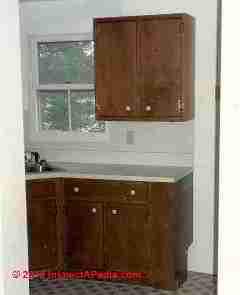 Kitchen Cabinet Choices & Design Guide
Kitchen Cabinet Choices & Design Guide
Best Practices
- POST a QUESTION or COMMENT about choosing & installing kitchen cabinets
Kitchen cabinet design guide:
This article describes the types of kitchen or bath cabinets available, cabinet grades (stock, semi-custom, custom), cabinet materials of construction (hardboard, particleboard, medium density fiberboard (MDF), plywood, solid wood), and cabinet finish choices (wood veneer, high-pressure laminate (plastic), melamine cabinets, vinyl finish cabinets, rigid thermofoil (RTF) cabinets, and painted cabinets).
InspectAPedia tolerates no conflicts of interest. We have no relationship with advertisers, products, or services discussed at this website.
- Daniel Friedman, Publisher/Editor/Author - See WHO ARE WE?
Kitchen Cabinet Choices & Design Guide
 This article includes excerpts or adaptations from Best Practices Guide to Residential Construction (Steve Bliss, J Wiley & Sons) , by Steven Bliss, courtesy of Wiley & Sons.
This article includes excerpts or adaptations from Best Practices Guide to Residential Construction (Steve Bliss, J Wiley & Sons) , by Steven Bliss, courtesy of Wiley & Sons.
Kitchen cabinets range widely in styles, materials, and levels of quality. Well-made cabinets feature sturdy cabinet boxes and drawers, stiff shelves that resist sagging, and solid hardware that operates smoothly.
Higher-end cabinets make greater use of veneer-core plywood rather than medium-density fiberboard (MDF), particleboard, or other composites.
[Click to enlarge any image]
Doors, drawer fronts, and visible end panels in premium cabinets make use of solid wood, real wood veneer, or high-pressure plastic laminate. At a glance, it is not always easy to discern quality levels since the best wood-grain vinyl facings do a surprisingly good imitation of real wood, at least until someone dents or scratches a corner.
With so many variables, it is not surprising to find that a set of cabinets for a midsize kitchen could range in price from as little as $3,000 for builder-grade cabinets picked up at a home center to as much as $20,000 for a custom high-end job.
Here we review cabinet grades: definition of stock cabinets, semi-custom kitchen cabinets, and custom kitchen cabinets. Guide to cabinet panel materials: hardboard, particleboard, medium density fiberboard (MDF), plywood, solid wood. Guide to cabinet finishes: wood veneer, high-pressure laminate (plastic), melamine cabinets, vinyl finish cabinets, rigid thermofoil (RTF) cabinets, and painted cabinets.
Guide to Wall Cabinet Grades
 The cabinet industry generally divides cabinets into three main
grades: stock, semicustom, and custom.
The cabinet industry generally divides cabinets into three main
grades: stock, semicustom, and custom.
- Stock cabinets are mass-produced in factories in
standard sizes, typically in increments of 3 inches,
although all sizes may not be available for certain items.
Each line comes in a limited number of materials, styles, and options.
These are the least expensive option with the quickest delivery time, but usually not the best quality. Fillers are used to fit the cabinets into place.
A 12-inch stock oak front cabinet is illustrated at left and others of this series at the top of this page. - Semicustom cabinets (Illustrated above in solid birch) may be similar to stock cabinets
in quality level or may be significantly better.
Since these are made to order, however, the buyer has many more choices for wood species and finishes, laminates, door styles, and storage options and accessories.
More cabinet sizes, including special heights and depths, are often available. Like stock cabinets, these are built in 3-inch increments, requiring filler strips for installation. - Custom cabinets are made to order by smaller shops
for an individual job.
Each shop has its own preferred materials, styles, options, and details; but for enough money, most shops will create whatever is requested. With a custom fit, filler blocks are not needed.
Cabinet Materials & Cabinet Panel Products
 Cabinets use a wide variety of substrate
materials for panels. The solid cherry front stock cabinets (left) were installed by the editor during renovations of an 1876 home in Wappinges Falls, NY in the 1980's.
Cabinets use a wide variety of substrate
materials for panels. The solid cherry front stock cabinets (left) were installed by the editor during renovations of an 1876 home in Wappinges Falls, NY in the 1980's.
The main cabinet panel products, typically covered with a wood, melamine, or vinyl veneer, are listed below:
- Hardboard, sometimes referred to by the brand Masonite®, is made from compressed wood fibers and lignin or phenolic resin. It swells and degrades when wet and is used for drawer bottoms, backs, and bottoms of lower-end cabinets.
- Particleboard is made from small wood particles that
are resin-bonded under pressure and heat. Type I uses
urea-formaldehyde resin and Type II uses water resistant
phenol-formaldehyde resin. Density classes
are L (low), M (medium), and H (high).
Better cabinets use medium-density stock (40 to 50 pounds/cu ft). Some also use Type II, which is water-resistant and has little off-gassing of formaldehyde. Also see FORMALDEHYDE GAS HAZARD REDUCTION .
Particleboard tends to swell when wet, and it is used widely for cabinet panels, shelves, and doors. Formaldehyde off-gassing may be a concern. - Medium-density fiberboard, or MDF, is a high-quality
substrate made from fine fibers and urea-formaldehyde
resin. It is more stable than plywood, stiffer than
particleboard, and less affected by water. Its surface
is smoother than particleboard and can be routed,
shaped, and painted.
MDF is widely used for all cabinet panels and shelves. A 36- to 38-lb/cu ft density is adequate for most applications, although some use 42- to 48-pound material. The high formaldehyde content is a concern to individuals concerned about off-gassing. - Plywood is made from thin wood sheets laminated to each other with the grain running at right angles in alternate plies for strength. Interior grades, typically used in cabinets, use urea-formaldehyde resin. Better quality cabinets use plywood for cabinet panels, shelves, and drawer bottoms. Plywood resists water damage.
Guide to Cabinet Finishes
These are the most common finish materials used for cabinet sides, interiors, and door and drawer fronts.
- Wood veneer cabinets. Wood veneer is a thin layer of wood
bonded to particleboard, MDF, or plywood to give
the appearance of solid wood. Used in both flat and
raised panels, veneer provides good grain matching.
Veneered panels rarely have problems, although
scratches or dents are easier to repair on solid wood.
Very high heat or humidity can cause cracking or delamination. The finish may be a simple solvent-based varnish or a more advanced and expensive multi coat system. - High-pressure laminate cabinets. Often called “plastic laminate,”
high-pressure laminate is composed of layers of
resin-saturated kraft paper with a clear melamine finish.
High-pressure laminate is widely used on countertops because it is inexpensive, durable, and easy to clean.
Scratches and damage are difficult to repair, however. It is used on door and drawer fronts and occasionally on side panels. Color-through laminates are also available at a higher cost. These hide chips and scratches better and do not leave a telltale dark edge at corner seams. - Melamine cabinets. Also known as low-pressure laminate,
melamine is thinner and less durable than high-pressure
laminate. It comes applied to particleboard or MDF
with a paper layer under the melamine that provides
the color or wood grain.
Low-pressure laminate can chip or crack and may discolor over time. It is used widely on cabinet boxes and door backs, and on door and drawer fronts on low-end cabinets. - Vinyl cabinets. Vinyl is a plastic sheet material that comes
applied to a particleboard or MDF substrate, and is
printed with a wood-grain or other pattern. It is
typically 2 to 4 mils thick and is not as durable as
melamine, although the heavier 4-mil material resists
scratches fairly well.
Exposed, unfinished edges are prone to damage, and scratches or dents are difficult to repair. - Rigid thermofoil (RTF) cabinets. RTF is a rigid PVC sheet
that is heated, vacuum-formed, and glued onto MDF
doors and moldings, creating a seamless face.
Most RTF doors are shaped to simulate a raised panel door. Thermofoil is available in many colors and woodgrain patterns, although white is the most common.
High-quality RTF is durable, scratch-resistant, and resists yellowing—a problem with some of the early formulations.
Better products carry warranties of five or more years. When using wood-grain thermofoil, it is best to use full-overlay doors and matching thermofoil moldings, since real wood finishes will age differently than the thermofoil. Many thermofoil doors have matching melamine backs. - Painted cabinets. There are a number of high-quality painted
finishes that are durable, lustrous, and resistant to
crazing, chipping, or yellowing.
Polyester paint, also used on cars and appliances, is a very expensive option that requires many coats that are oven-cured and wet-sanded by hand. The finish can be gloss or matte and fills the pores of the wood, giving it a solid appearance.
Catalyzed enamel paint is a less expensive option that uses a two-part formula to achieve a similar lacquer like finish. Although these paints resist chipping, nicks are difficult to touch up and blend in. Also hairline cracks will typically appear at the joints in solid wood doors due to expansion and contraction—not a problem with a dimensionally stable substrate such as MDF.
Also see CABINETS & COUNTERTOPS
This article series discusses current best design practices for kitchens and bathrooms, including layout, clearances, work space, and accessible kitchen and bathroom layout, clearances, turning space, grab bars, controls, etc. We include advice on choosing and installing kitchen countertops, cabinets, and kitchen or bathroom flooring, sinks, and other plumbing fixtures and fixture controls such as faucets. A list of kitchen and bath product manufacturers and sources is included.
Kitchen Cabinet Associations, Hardware, Manufacturers List
- Accuride International www.accuride.com Ball-bearing drawer slides
- Amerock Corp. www.amerock.com Comprehensive catalog of cabinet hinges, pulls, slides, and accessories
- Grass America www.grassusa.com Cup hinges, slides, shelf supports, and storage accessories
- Hafele America www.hafeleamericas.com Cup hinges, ball-bearing slides, pulls, and KD connectors
- Mepla Inc. www.mepla-alfit.com Cup hinges, ball-bearing slides, drawer systems, shelf supports, and KD connectors
- Hettich America www.hettichamerica.com Cup hinges, ball-bearing drawer slides, shelf supports, and KD connectors
- Association of Home Appliance Manufacturers(AHAM) www.aham.org
- National Kitchen and Bath Association (NKBA) www.nkba.org
Also see these catalog pages:
- AMERICAN KITCHENS CATALOG 1950 [PDF] steel kitchen cabinets dont' warp, swell or rot ... and they're easier to clean and never need painting. Less costly than wood cabinets.
- FORMICA COUNTERTOPS CATALOG 1950 [PDF]
- YOUNGSTOWN KITCHENS CATALOG 1950 [PDF]
-- Adapted with permission from Best Practices Guide to Residential Construction (Steve Bliss, J Wiley & Sons) .
...
Continue reading at CABINET CHOICES, Bath / Kitchen or select a topic from the closely-related articles below, or see the complete ARTICLE INDEX.
Or see these
Recommended Articles
- CABINETS & COUNTERTOPS - home
- CABINET CHOICES, Bath / Kitchen
- CABINET DESIGN GUIDE, KITCHEN
- CABINET DOOR HINGES
- CABINET FALLING HAZARDS
- CABINET INSTALLATION & REPAIR MANUALS
- CABINET MOLD & WATER DAMAGE
- CASEWORK, CABINETS, SHELVING INSTALLATION
- COUNTERTOPS, KITCHEN & BATH
- COUNTERTOPS, KITCHEN & BATH
- FORMALDEHYDE GAS HAZARD REDUCTION
Suggested citation for this web page
KITCHEN CABINET DESIGN GUIDE at InspectApedia.com - online encyclopedia of building & environmental inspection, testing, diagnosis, repair, & problem prevention advice.
Or see this
INDEX to RELATED ARTICLES: ARTICLE INDEX to BATH & KITCHEN
Or use the SEARCH BOX found below to Ask a Question or Search InspectApedia
Ask a Question or Search InspectApedia
Questions & answers or comments about choosing & installing kitchen cabinets.
Try the search box just below, or if you prefer, post a question or comment in the Comments box below and we will respond promptly.
Search the InspectApedia website
Note: appearance of your Comment below may be delayed: if your comment contains an image, photograph, web link, or text that looks to the software as if it might be a web link, your posting will appear after it has been approved by a moderator. Apologies for the delay.
Only one image can be added per comment but you can post as many comments, and therefore images, as you like.
You will not receive a notification when a response to your question has been posted.
Please bookmark this page to make it easy for you to check back for our response.
IF above you see "Comment Form is loading comments..." then COMMENT BOX - countable.ca / bawkbox.com IS NOT WORKING.
In any case you are welcome to send an email directly to us at InspectApedia.com at editor@inspectApedia.com
We'll reply to you directly. Please help us help you by noting, in your email, the URL of the InspectApedia page where you wanted to comment.
Citations & References
In addition to any citations in the article above, a full list is available on request.
- Best Practices Guide to Residential Construction, by Steven Bliss. John Wiley & Sons, 2006. ISBN-10: 0471648361, ISBN-13: 978-0471648369, Hardcover: 320 pages, available from Amazon.com and also Wiley.com. See our book review of this publication.
- Our recommended books about building & mechanical systems design, inspection, problem diagnosis, and repair, and about indoor environment and IAQ testing, diagnosis, and cleanup are at the InspectAPedia Bookstore. Also see our Book Reviews - InspectAPedia.
- American Plywood Association, APA, "Portland Manufacturing Company, No. 1, a series of monographs on the history of plywood manufacturing",Plywood Pioneers Association, 31 March, 1967, www.apawood.org
- In addition to citations & references found in this article, see the research citations given at the end of the related articles found at our suggested
CONTINUE READING or RECOMMENDED ARTICLES.
- Carson, Dunlop & Associates Ltd., 120 Carlton Street Suite 407, Toronto ON M5A 4K2. Tel: (416) 964-9415 1-800-268-7070 Email: info@carsondunlop.com. Alan Carson is a past president of ASHI, the American Society of Home Inspectors.
Thanks to Alan Carson and Bob Dunlop, for permission for InspectAPedia to use text excerpts from The HOME REFERENCE BOOK - the Encyclopedia of Homes and to use illustrations from The ILLUSTRATED HOME .
Carson Dunlop Associates provides extensive home inspection education and report writing material. In gratitude we provide links to tsome Carson Dunlop Associates products and services.

